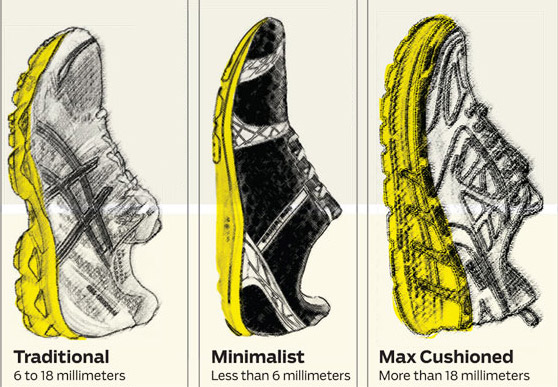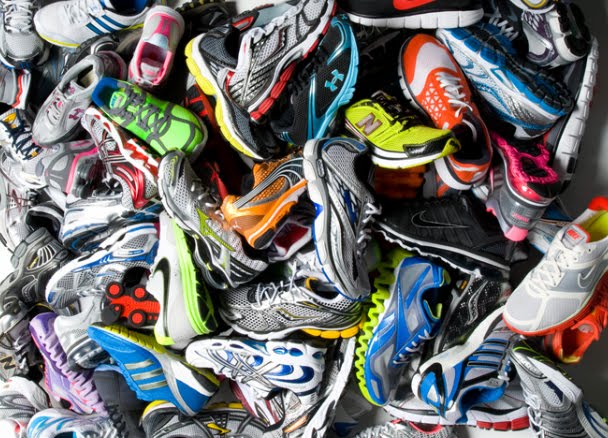If you're like me, choosing new running shoes is an insane process. You read reviews, you think about what has worked well for you in the past, and you become maddeningly befuddled by a tsunami of information. What amount of drop is best? Is lighter always better? Which type of cushioning is ideal?
I tend to get frustrated and just decide that it all just boils down to what feels good on my feet. But then I wonder if my running economy
could be improved and my injury potential reduced even
more if I were in shoes with the perfect blend of drop, cushioning, structure, responsiveness...yady yady ya...and back down the rabbit hole I go.
It doesn't help that running shoe manufacturers each have patented super buzz words for their myriad of technologies, each one with its own promises of awesomeness. It can be easy to get lost in the minutia of science, innovation, and marketing, where many of us find ourselves asking what the best type of shoe really is.
The answer is....there is no answer. Everyone is different. That sentence was painfully cliche to type, but its the simple truth. Despite what simple running shoe store gait analyses would suggest, the right type of shoe for an individual depends on many, many factors beyond simply pronation and foot strike. At the end of the day, trial and error is your best bet.
But since that truth won't stop many of us from incessantly researching shoes, I want to first clarify some of the concepts surrounding shoe dynamics, and then propose a hypothesis of my own creation about "training" our takeoff.
The Case For Shoe Rotation
One interesting notion that has emerged in recent years is the idea of rotating running shoe types. Not just keeping two or three pairs of the
same running shoe and alternating use so that the foam has time to "recover" and rebound in between runs (not totally convinced that's true anyway). I'm talking about keeping two or three (or more?) pairs of
different running shoes that are worn for different types of runs. It wasn't too long ago that only elites really practiced this, though with different shoes within the same brand that was sponsoring them, most likely. They have an everyday high-mileage trainer, an uptempo trainer, road racing flats, and spikes (if they run track distances). Recreational runners might also sport a quiver of shoes like this if they race seriously or do any track competition, but most age-groupers tend to race in their trainers, keeping only one pair of running shoes at a time.
"I have too many running shoes" - no runner ever
I'm sure it could be argued that this advice precipitated down from running shoe manufacturers as a way to get runners to buy more shoes. But that doesn't actually make much sense, since someone with one pair of running shoes will wear them out much faster than someone rotating between three or four pairs, so the mileage on the shoes all comes out in the wash.
The biggest reason for this advice has to do with injury prevention. The many intricate muscles and tendons in our feet, ankles, legs, knees, thighs, and hips are strained differently in different types of running shoes. By rotating between different shoe types and brands, we essentially train our lower bodies to respond in different ways, reducing overuse on the same muscle and tendon groups from daily overloading.
What do I mean by different "types" of running shoes? I can start by saying that I do NOT mean switching between motion control and neutral running shoes if you run healthily in one or the other. If you badly overpronate and run well in motion control shoes, then stick with motion control shoes. What I am referring to here are cushioning and heel-to-toe drop.
For example, if you are currently wearing a motion control shoe with a 12mm heel-to-toe drop that is heavily cushioned, maybe use this show as your everyday trainer and invest in a less-cushioned motion control shoe with an 8mm drop to use as your uptempo or speed shoe. Or if you currently run in a firm neutral shoe with a 4mm drop, perhaps invest in a more cushioned (to your comfort) neutral show with a 10mm drop to use for easy/recovery runs.
In both examples, prior to acquiring a second pair of shoes, your tendons (particularly your achilles tendons) were accustomed to extending to a certain length during your stride under normal conditions. But when your running shoes start to wear out, or when you are in the last miles of a marathon and your form begins to suffer, that length changes, and injury can result. If your tendons are accustomed to extending to varied lengths during your training, they become more resilient under stressed conditions and you are less likely to suffer injuries in those tendons.
Switching up cushioning is a similar concept. The muscles, tendons, and sensory reflexes of your feet also become accustomed to the level of shock absorption your everyday trainers provide. Switching immediately into a very firm shoe can result in injuries simply because your feet, knees, etc have to now respond very differently to higher impact than they might be prepared to handle, hence the slough of injuries that followed the barefoot running fad. But say you train it two different pairs of shoes, one highly cushioned and one moderately or lightly cushioned, and you rotate between the two on a weekly basis, your musculoskeletal system can gradually adapt to these differences in cushioning, and actually make this system stronger.
Here is an excellent take on shoe rotation:
Why You Should Have A Quiver Of Running Shoes
Train Soft, Race Hard
Let's sink into cushioning just a little deeper (see what I did there?), with respect to running economy and responsiveness. Generally, more soft and cushioned shoes are considered less "responsive" or "snappy", meaning the energy you push into the ground at takeoff does not rebound as strongly as a more firm shoe. This makes sense when you consider what cushioning does: absorb shock. True, in the long run this can reduce forces exerted on your joints, hence the recent popularity of Hoka One One shoes among longer-distance runners and older runners (many running physiologists would argue that this level of cushioning is not necessary to protect joints if your form is efficient, but that is for another post).

The reduced impact comes at a cost, though, in the form of running economy. When energy is absorbed by soft cushioning, it does not return in the takeoff phase of the stride, meaning it takes more energy to achieve a strong takeoff, and is thus less economical. It's the same reason why you have to exert more energy running on sand to achieve a given pace than you do running on pavement: too much energy is absorbed in the sand and not returned.
The type of cushioning does matter in this. Some materials return energy more than others. Gel cushioning, which is the trademark of Asics shoes, returns very little energy. Foam cushioning, as seen most notably in Adidas and Saucony brands, can return more energy depending on the density of the foam. These brands and others have, most recently, been working to develop ideal differential densities in their cushioning to optimize energy return for takeoff (Adidas Energy Boost series, in particular) yet still provide a soft landing. There are other creative ways of achieving this, as Mizuno has developed with its "wave plate", a thin plastic plate embedded in the midsole among foam cushioning, making a firmer-feeling shoe with high responsiveness on takeoff but the foam still cushions the landing.


 Adidas "Energy Boost" foam Saucony Kinvara 7s with new EverFoam Mizuno Wave Rider with the embedded wave plate
Adidas "Energy Boost" foam Saucony Kinvara 7s with new EverFoam Mizuno Wave Rider with the embedded wave plate
Okay, back to the main point here: if you wear very soft trainers, your muscles and tendons become accustomed to that level of responsiveness by working harder to push off the ground in the take-off phase.
Many runners do wear soft, more cushioned shoes for recovery and long runs, on which they are not as concerned with responsiveness or energy return but appreciate the softness on their joints, and then wear a more firm shoe for fast workouts and racing.
This is a good idea for the reasons mentioned above, and possibly for another reason, which brings me to my hypothesis...
Training in a soft cushioned shoe for recovery, easy, or long runs can train your musculoskeletal system for a stronger takeoff when you switch into firm, responsive shoes for workouts and racing.
This may sound pretty obvious, but I am honing in on a specific mechanism at work here: the "spring" achieved during the stance phase, between absorption and propulsion, ending in toe-off.
In a softer shoe, energy is absorbed on impact but less is returned in toe-off. In a firmer shoe, especially on firm surfaces, energy absorbed on impact "bounces back" in toe-off. If you train in a softer shoe, making your feet, ankles, and shins accustomed to working harder to toe-off, you can create a "springier" toe-off when you then slip into a more firm shoe.
Many people do this already, but for a different reason: the difference in weight between a heavy, cushioned shoe and a light, firm shoe. This certainly can make your stride feel lighter during workouts and races, kind of like how Tennessee Walker horses are trained. But my hypothesis isn't about the shoe's weight, it's about responsiveness. Think of it like getting used to bouncing on a pogo stick with a loose-coil (soft cushiony shoes) and then switching to a pogo stick with a tight, firm coil (firm, responsive shoes) and feeling like it suddenly takes much less energy to get the same amount of bounce.
I'm calling this hypothesis "Springy Training", since you are essentially training your takeoff to be more "springy".
Thoughts???



























